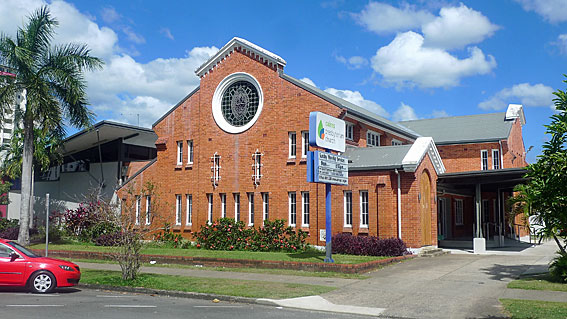
Cairns Presbyterian Church
[Photograph by Trevor Bunning (July 2015)]

Cairns Presbyterian Church
[Photograph by Trevor Bunning (July 2015)]
Historical and Technical Documentation by Geoffrey Cox
© OHTA 2011, 2015 (last updated July 2015)
Cairns was established as early as 1876 as a port for the Hodgkinson River goldfields. It was not until after 1924, when the railway line from Brisbane reached the area, that it became the leading city of the region. It is now a major tourist destination.
The foundation stone of the present Presbyterian Church was laid in August 1952. Designed in 'Norman cloistered style' and constructed in red brick with a timbered ceiling, the building was opened and dedicated on Saturday 28 March 1953 by the Moderator of the Assembly of the Presbyterian Church in Queensland, the Right Rev. Malcolm MacDermant.1 It replaced an earlier wooden church, in which a harmonium had been used.
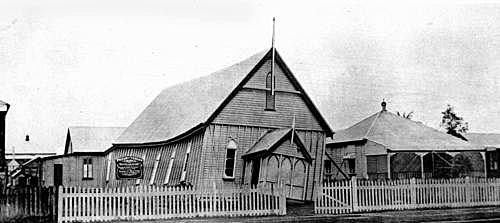
The first Cairns Presbyterian Church,
showing the effects of the March 1918 cyclone
[Photograph: John Oxley Library, State Library of Queensland]
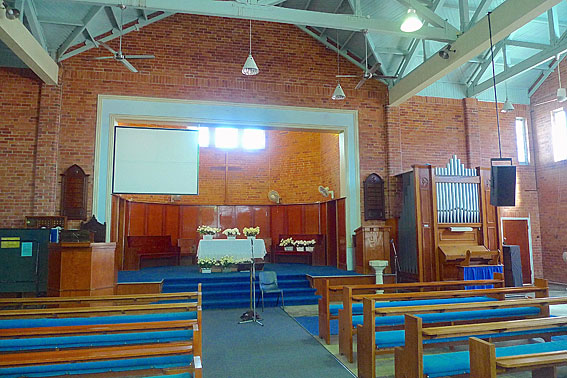
Interior of the present Cairns Presbyterian Church
[Photograph by Trevor Bunning (July 2015)]
There were plans to purchase a pipe organ for the new church at the time of the opening. The present instrument was purchased from Robert Spurden Rutt & Co. Ltd. of London at a cost of £3,165.10.0, and installed around August 1956 by local optometrist Mr Noel Ferguson.2 The organ is dedicated to the memory of Leonard Simpson.
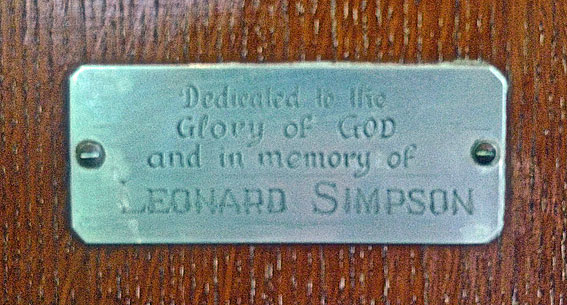
Memorial plaque on the organ
[Photograph by Trevor Bunning (July 2015)]
Established in 1899, the Spurden Rutt firm exported organs throughout the world,3 although only two came to Australia. The other example dates from the mid-1920s, being located until 1967 at St John's Anglican Church, Bairnsdale, Vic, and subsequently at St Philip's Anglican Church, West Heidelberg, Vic.4
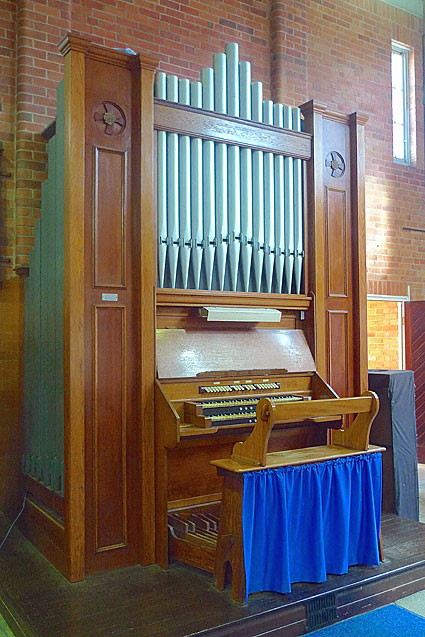
The 1956 Spurden Rutt organ
[Photograph by Trevor Bunning (July 2015)]
The Spurden Rutt firm specialised around the middle of the century in small economical electric-action organs, and this modest three-rank extension instrument testifies to their durable construction. The pipework is entirely enclosed, apart from the bottom octave of the Pedal Bourdon (which is located outside the case along the two sides) and the lowest notes of the Open Diapason. The swell shutters are horizontal and located, unusually, on the back of the swell box. The metal façade pipes are non-speaking.
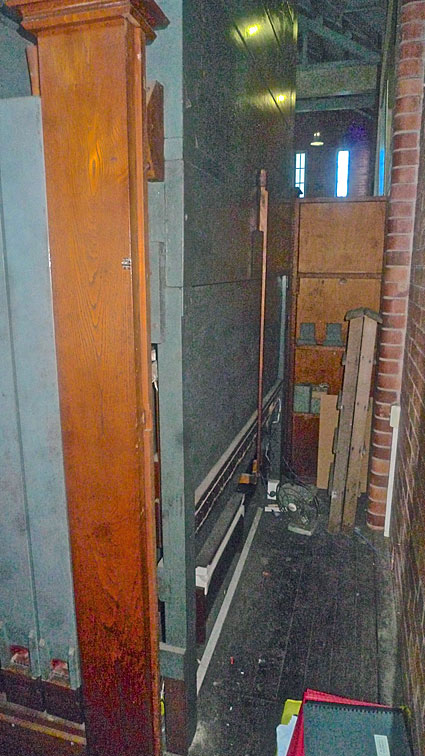
Horizontal Swell shutters at the rear of the organ
[Photograph by Trevor Bunning (July 2015)]
This is now the only surviving pipe organ in Cairns, and it has survived in isolation with minimal maintenance over the years. The bellows (single-rise) were re-leathered and the pedals re-felted and re-bushed in 2000 by Ian D. Brown & Associates of Ballina.5
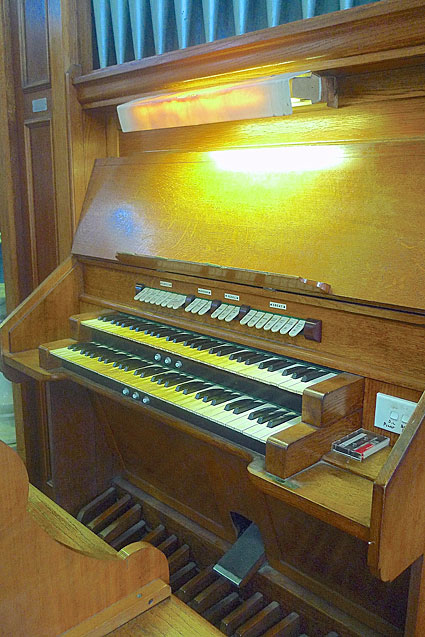
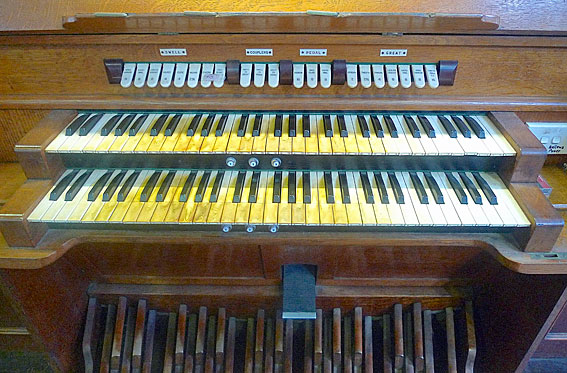
Console of the Spurden Rutt organ
[Photographs by Trevor Bunning (July 2015)]
| GREAT Contra Viola Open Diapason Salicional Lieblich Gedeckt Principal Twelfth Fifteenth SWELL Open Diapason Salicional Lieblich Gedeckt Salicet Flute Nazard Flautino PEDAL Bourdon Bass Flute Salicional COUPLERS Swell to Great (mechanical) Swell to Pedal Great to Pedal |
16 8 8 8 4 2-2/3 2 8 8 8 4 4 2-2/3 2 16 8 8 |
A B A C B A A B A C A C C C C C A |
[Ten. C] |
Electric action
Attached stop-key console
Swell tremulant
Balanced swell pedal
Pedalboard: radiating & concave
Compass: 61/30
3 thumb pistons to Great
3 thumb pistons to Swell.6
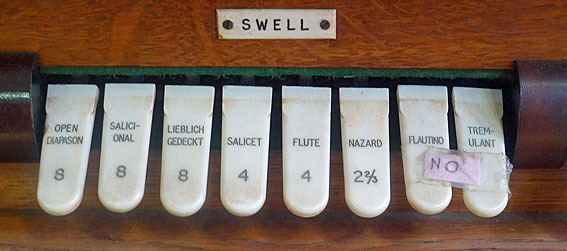
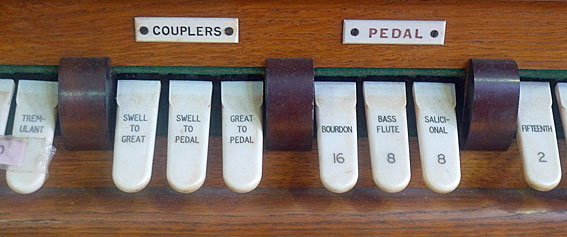
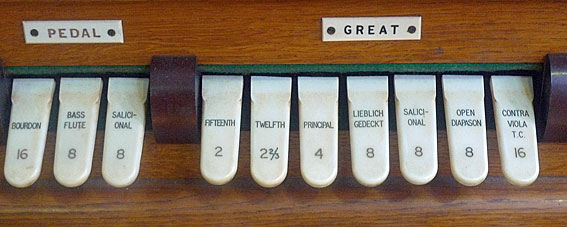
Stopkeys of the Spurden Rutt organ
[Photographs by Trevor Bunning (July 2015)
________________________________________________________________________
1 Cairns Post (30 March 1953), p. 1; Cairns Post (31 March 1953), pp. 1, 5.
2 Details of builder & dates supplied to G. Cox by Rev. C.D. Balzer, May 1974.
3 Dictionary of Organs and Organists, ed. Frederick W. Thornbury, 2nd edn (London: Mate, 1921), p. 458.
4 OHTA News, vol. 28, no 4 (October 2004), p. 7 & vol. 29, no. 2 (April 2005), p. 11.
5 The Organ Voice, vol. 26, no. 4 (December 2000), p. 25.
6 Specification noted by G. Cox, July 1974 and October 2003; see also: The Organ Voice, vol. 23, no. 4 (December 1997), pp. 20-21.